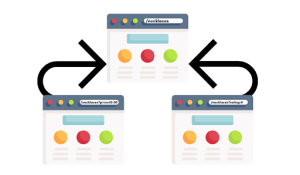Duplicate content can quietly weaken your SEO, leading to lower visibility and missed sales opportunities. In technical SEO ecommerce, tackling duplicate content is essential. While Google might not directly punish your site for it, duplicate pages can confuse search engines and water down your authority. Neil Patel points out that even though it won’t always damage rankings outright, it can still affect how well your site performs by making it harder for search engines to decide which page to show.
From product pages that repeat manufacturer descriptions to multiple URLs showing identical content, these issues can quietly reduce search visibility. Search engines struggle to decide which version of a page to prioritize, sometimes leading to reduced rankings, indexing errors, or even keyword cannibalization.
This article explores how duplicate content impacts ecommerce SEO and what can be done to fix and prevent it.
What Is Duplicate Content?
Duplicate content refers to blocks of text or code that appear on more than one page across the same domain or on different websites. In ecommerce, it often results from:
- Product variants with near-identical descriptions
- Pagination issues
- Category filters generating multiple URLs for the same product
- Manufacturer-supplied descriptions reused across retailers
- HTTP and HTTPS versions of pages coexisting

While search engines do not penalize all duplicate content directly, they may choose not to index or rank pages that lack originality or clear signals about which version is authoritative.
Why Ecommerce Sites Are at Risk
Ecommerce platforms naturally produce large volumes of similar content. A store selling 1,000 products in 5 color options and 4 sizes can generate tens of thousands of URLs. Without control measures, these pages can appear identical in structure and content.
Common contributors:
- Faceted navigation: Filters like size, brand, and color can create countless URL variations, all pointing to the same core product.
- Session IDs in URLs: These can create dynamic links that search engines interpret as separate pages.
- Syndicated content: Using the same product description provided by the manufacturer as every other seller dilutes originality.
How Duplicate Content Affects SEO Performance
1. Wasted Crawl Budget
Search engines allocate a limited number of pages to crawl for each site. When crawlers waste time on duplicate versions, important pages might be skipped or delayed in being indexed.
2. Diluted Ranking Signals
When multiple pages have the same or similar content, backlinks and internal links are split among them. Instead of one strong page accumulating value, the signals are divided across duplicates.
3. Keyword Cannibalization
Multiple pages targeting the same keyword with near-identical content may compete against each other in search results. This can prevent the most relevant version from ranking well.
Identifying Duplicate Content Issues
A thorough audit is the best starting point. Tools like Screaming Frog, Sitebulb, and Ahrefs can scan ecommerce sites to reveal duplicate titles, meta descriptions, H1s, and body content. Google Search Console also highlights indexing issues related to duplicates under “Pages” in the Indexing report.
Other indicators:
- Multiple URLs showing identical content when filters are applied
- Variants of a product that are accessible through different paths but offer no unique content
- High bounce rates and low time-on-page across duplicated pages
Preventing Duplicate Content on Ecommerce Sites
Canonical Tags
A canonical tag tells search engines which version of a page should be treated as the primary one. For example, a red t-shirt in five sizes and three colors may use canonical tags to point to the main product URL.
Tips:
- Use consistent canonical tags across all product variant pages
- Ensure canonical URLs point to indexable and crawlable pages
- Avoid self-referencing canonicals on paginated pages unless necessary
URL Parameter Management
Parameters in URLs created by filters or tracking codes can lead to duplicate pages. Google’s URL Parameter Tool (in legacy Search Console) and robots.txt can help manage this.
What to do:
- Block parameters that don’t change page content (e.g., sort order or session IDs)
- Configure filters to use AJAX instead of generating new URLs, if possible
- Apply rel=“prev” and rel=“next” for paginated content to show continuity
Unique Product Descriptions
Using default product descriptions from suppliers creates duplication across multiple sites. Writing custom descriptions that highlight different benefits, use cases, or target keywords increases uniqueness.
Additional ways to diversify content:
- Include customer reviews
- Add FAQs related to the product
- Create usage tips, video demos, or compatibility guides
Fixing Existing Duplicate Content
When duplicate pages already exist, a structured cleanup is needed. Prioritize based on impact and feasibility.
Steps:
1. Redirect duplicates: Use 301 redirects for outdated or low-value versions of a page.
2. Consolidate content: Merge similar pages and keep only the most complete or authoritative version.
3. Update canonical tags: Ensure they point to the preferred version of the page.
4. Remove thin duplicates: Pages that offer no unique value and cannot be consolidated should be deindexed.
The Role of Structured Data
Structured data helps search engines understand the context of each product page. While it doesn’t solve duplication, it strengthens individual page signals.
Best practices:
- Use schema.org markup for products, reviews, offers, and availability
- Avoid marking up multiple products on pages not intended to rank individually
- Validate schema with Google’s Rich Results Test
Managing Duplicate Content Across Domains
For businesses operating multiple sites in different regions or languages, duplication may occur across domains. Proper use of hreflang tags ensures the correct regional version is shown in search results.
Key actions:
- Implement hreflang for multilingual or multi-regional sites
- Ensure each language variant has a unique URL
- Keep content localization authentic; avoid machine translation duplication
Monitoring Ongoing Risk
After addressing issues, ongoing monitoring helps prevent new duplicate pages from appearing. Regular audits using crawling tools and content comparison software can flag problems before they grow.
Routine checks:
- Run monthly audits for duplicate meta tags and body content
- Monitor crawl stats in Search Console for unexpected indexing drops
- Review site logs to detect unusual crawl behavior
Conclusion
Common culprits in ecommerce include identical product descriptions across multiple URLs, pagination issues, and filtered results creating similar content pages. Addressing these issues is crucial; as highlighted by most SEO specialists, resolving duplicate content problems can lead to significant improvements in keyword rankings and overall site performance.With structured audits, proper tagging, and thoughtful content management, these issues can be minimized.
A consistent approach to technical SEO ensures better crawl efficiency and a stronger presence in search results.

